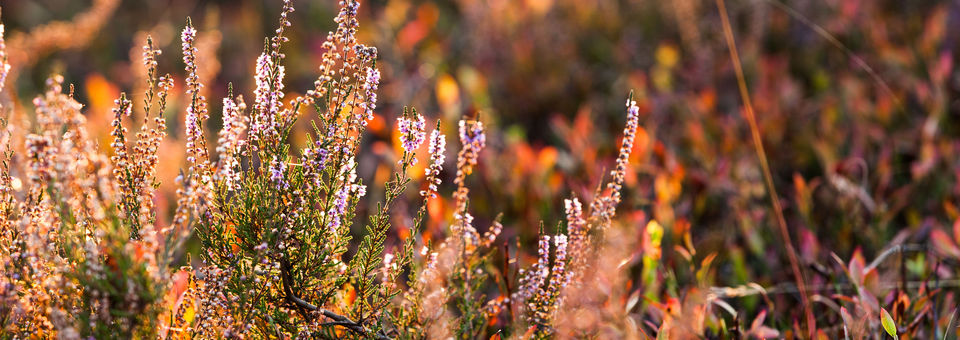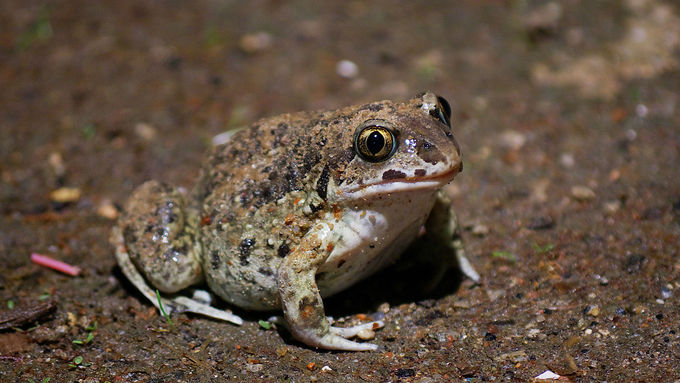Knoblauchkröte/Common spadefoot (Pelobates fuscus) © -ani-/CC BY-SA 2.0 DE
download picturemain content
Protected Species
PELOBATES FUSCUS (1197)
Common Spadefoot
The Common Spadefoot has a body length of four to eight (usually six to seven) centimetres and thus is one of the smaller native anurans. Its body shape with the relatively large head seems a bit plump. Females, on average, are slightly larger than males. The body colour varies in brown and grey shades. On the upper side, the animals have an individually distinct pattern of light to dark brown longitudinal bands; occasionally, they are also spotted or almost without any marking. The underside is whitish, sometimes dappled or spotted. The rounded snout and the prominent eyes with vertical, slit-shaped pupils are the main characteristics. The yellow-coloured digging calluses on the hind feet allow for a safe determination of adult animals; they enable the animals to dig into sandy soil fast as lightning. As an alternative behaviour for enemy defence, the Common Spadefoot can also inflate and secrete a foul-smelling secretion; the smell of garlic led to its alternative name garlic toad. The mating calls - a soft, mostly triple "wock ... wock ... wock" - are emitted under water and remind of a distant knock.
Habitat and biology
The thermophilic Common Spadefoot prefers open biotopes near suitable spawning waters with loose soil into which it can dig deep burrows. Due to its secretive way of living, it is one of the most difficult species of amphibians to monitor. Besides heaths, rough meadows and sandy areas in larger floodplains, they also colonize sandy arable land (asparagus and potato fields), meadows, pastures, parks, gardens or sand and gravel pits. As spawning waters, the Common Spadefoot prefers stagnant waters that permanently bear water, are not too shallow and partially shaded to sun-exposed, with water plants for attaching the egg strings. Depending upon the ambient temperature, they move into the winter habitats in late September/ mid-October. The animals then dig themselves into a depth of 60 to a maximum of 100 centimetres.
In March to April, the migration to the spawning waters takes place. The reproductive period lasts from April to May; with extensive rainfall, a second spawning season may follow from June to mid-August. After the spawning season, the adults migrate into the terrestrial habitats which are within a radius of 600 meters at most. The larvae hatch after about eight days. Older larvae stand out because of their enormous size of up to 19 centimetres. The metamorphosis takes place after three to four months. The young toads then leave the waters between the end of June and the middle of September and move into their winter habitats in autumn. The adults also migrate to their winter habitats from October on. Larvae from eggs which had been laid late in the season overwinter in the waters and do not complete their metamorphosis until the following year. Sexual maturity is reached after one to two years. The lifespan in the wild is five to a maximum of nine years, and up to eleven years in captivity.
Occurrence
The Common Spadefoot reaches its western distribution limit in Germany. Nationwide, it is considered as “Vulnerable” (VU). In North Rhine-Westphalia, it is classified as "Critically Endangered“ (CR) and dispersed only in the lowlands, with a main distribution range in the Westphalian Lowland (Münsterland).
In Lower Saxony, the species is listed as “Vulnerable” (VU) and reaches the limits of its north-western distribution along the Ems or the border demarcation to the Netherlands. Its main areas of distribution in Lower Saxony are in the eastern, sub-Atlantic-continental lowlands, in parts of the natural regions “Stade Geest“ and “Lüneburg Heath and Wendland“ (with the the Middle Elbe Plain) as well as in the “Weser-Aller Plains and Geest“.
Threats
The observed decline of the species is in all likelihood associated with intensive agricultural farming practices with regard to land consolidation and the direct loss of spawning waters and terrestrial structural elements in the agricultural landscapes. Other factors include drawdown or the (early) dry falling of small waterbodies, natural changes due to succession, the conversion to fish ponds as well as extreme weather conditions which may also lead to unsuitable spawning conditions. There are also restrictions due to the removal of adjacent biotopes and vegetation elements as well as due to fragmentation of main habitats through road and settlement construction.
Types of action
Basic implementation actions for the protection and improvement of the conservation status are aimed at the preservation and restoration of non-fragmented waterbodies in which the individual ponds are, if possible, no more than one to three kilometres apart from each other. In order to protect individual populations of the Common Spadefoot, it is important to consider the entire annual habitat (biotope complexes of spawning, summer and winter habitat). The spawning waters as the centre of the annual habitat should be particularly protected against intrusions and disturbances; the surroundings in a radius of at least 600 metres should only be cultivated extensively if possible. In addition, the species’ spawning and terrestrial habitats should be optimised, by removing or cutting back wood that casts a shadow on the bank, preventing nutrient inputs into the water through adequate buffer zones, and avoiding the use of fertilizers and promoting border biotopes without cultivation as well as barren land and fallow, arable land in areas with loose sandy soils. Furthermore, there should be no fish stocks in spawning waters.
Actions within phase 1 of the LIFE IP
In the first phase of the project, six actions focusing on improving the conservation status of the Common Spadefoot will be implemented in North Rhine-Westphalia. Four of these actions are directly related to the breeding station for the Common Spadefoot in Enniger and target the reintroduction of the species. In addition, spawning waters and surrounding terrestrial habitats will be optimized or created. Synergy effects are expected for the respective habitat types (e.g. 2310, 3130) and other species inhabiting these habitats, such as the crested newt.
In Lower Saxony, in the first phase of the project five actions will be implemented which focus on improving the conservation status of the Common Spadefoot. The activities involve the (initial) restoration of habitats by removing seedlings and the improvement of habitats by means of desludging and reed mowing through to renaturation or creation of ponds. In one case, it is necessary to acquire an area to be able to create a new pond there.
Related Topics
additional information
Further Links
- Species profile „Common Spadefoot“ – State Agency for Nature, Environment and Consumer Protection (LANUV NRW) (in German) (external link opens in a new window)
- Implementation notes for the protection of the Common Spadefoot – Lower Saxony Water Management, Coastal Defence and Nature Conservation Agency (NLWKN) (in German) (external link opens in a new window)
- Species profile „Common Spadefoot“ – German Federal Agency for Nature Conservation (BfN) (in German) (external link opens in a new window)
- German Prioritised Action Frameworks (PAF): Common Spadefoot, page 128 – German Federal Agency for Nature Conservation (BfN) (in German) (external link opens in a new window)
- Red Lists and complete species list of Amphibians and Reptiles in Lower Saxony and Bremen (NLWKN) (in German) (external link opens in a new window)




